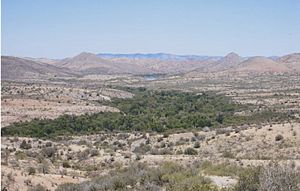Desert riparian facts for kids
A desert riparian area is a special place in the desert. It's where you find water at or near the surface for most of the year. Imagine a dry, sandy desert, and then suddenly, you see a green, lush area with tall trees! That's a desert riparian zone. These areas are often found at the bottom of canyons or along streams. They are like an oasis or a green ribbon following a water flow.
Contents
What Makes Desert Riparian Areas Unique?
Water in the Desert
Most deserts are very dry. But in desert riparian areas, there's enough water to support different plants and animals. This water can come from springs or underground streams. It's different from "dry washes," which only have water after a big rain.
Home to Many Animals
These green spots are super important for wildlife. Over 80% of all known desert animals use desert riparian areas. They come here for water, food, and shelter. It's like a busy neighborhood in the middle of nowhere!
Plants of the Riparian Zone
Many types of trees and plants grow here that can't survive in the dry desert. Some common trees you might see include:
- Fremont cottonwood (Populus fremontii)
- Arizona ash (Fraxinus velutina)
- Arroyo willow (Salix lasiolepis)
- Goodding's willow (Salix gooddingii)
- Red willow (Salix laevigata)
- California fan palm (Washingtonia filifera)
Invasive Plants
Sometimes, plants that are not native to the area can cause problems. These are called invasive species. They can take over and harm the native plants. Some invasive plants found in desert riparian areas are:
- Salt cedar (Tamarix ramosissima)
- Giant reed (Arundo donax)
- Russian olive (Elaeagnus angustifolia)
Salt cedar is especially tricky. It can soak up water more easily than native trees like cottonwoods and willows. This leaves less water for the plants that naturally belong there.
Old Home Sites
You might also find other non-native plants in these areas. This is because springs and water sources in the desert were often places where people used to live. They might have planted trees like elm, black locust, or fruit trees.


